In the video below, Art Tatum and his band are warming up at Three Deuces in New York City, Dec 5th 1943. Here is my transcription of it, with piano and bass.
This fun piece from 1912 was made popular by Al Jolson and other performers. It’s from the ragtime era (1900-1920) and is sometimes heard at ragtime festivals.
After seeing a version of this being played on a calliope, I found the original sheet music as published by F. A. Mills in 1912, and re-typeset it with just a few minor changes to improve the MIDI playback. The MIDI instrument “baritone sax” is supposed to mimic a calliope, but falls short.
The recommended tempo is 120 to the quarter note (duration 3:07 if using all repeats).
One thing led to another and I discovered Whitewash Man, a 1908 ragtime piece by Jean Schwartz.
First I saw Neville Dickie performing miscellaneous pieces at the 2018 West Coast Ragtime Festival, and subsequently looked him up on YouTube, where I saw his 2009 performance of The Whitewash Man, with Hal Smith accompanying on drums. This is a truly joyful arrangement by Mr. Dickie that is in a higher register than the original with expert embellishments.
Of course I found and downloaded the sheet music, where the only version to be found was the original publication, which is rather simple and dry (although not entirely trivial to play). I played it a lot and kind of customized my rendition, but have since stopped playing it that way in favor of the Sutton version below. Something close to the original can be seen here on a player piano and is not too exciting:
Further research turned up Ralph Sutton’s extremely jubilant performance, which was published on an album called Carolina in the Morning in January 1949. It can be heard below, and I managed to find a high quality FLAC audio file archived from a 78 record. Amazingly there were less than 90 views of this video in the past 5 years. Let’s fix that!
I wanted to be able to play this version, and decided to try transcribing it. I used the Transcribe! software, but soon gave up. The less-than-great audio quality and the complexity of the piece made it too hard to determine which notes were being played.
Around a year later, I ran across the AnthemScore software that claims to convert audio files into sheet music, and gave it a shot. Success! Although the music output by the program is a real mess, it gave innumerable insights into what the music might be, and then working with Transcribe! I was able to interpret and write down what I think is close to what Mr. Sutton played. This took entirely too much time.
Then I spent far too much time learning to play it at speed. I will try to record my (poor) rendition of this at some point. Here is a cover sheet I designed with the help of the Bing/DALLE-3 AI image generator and the GIMP image editor:
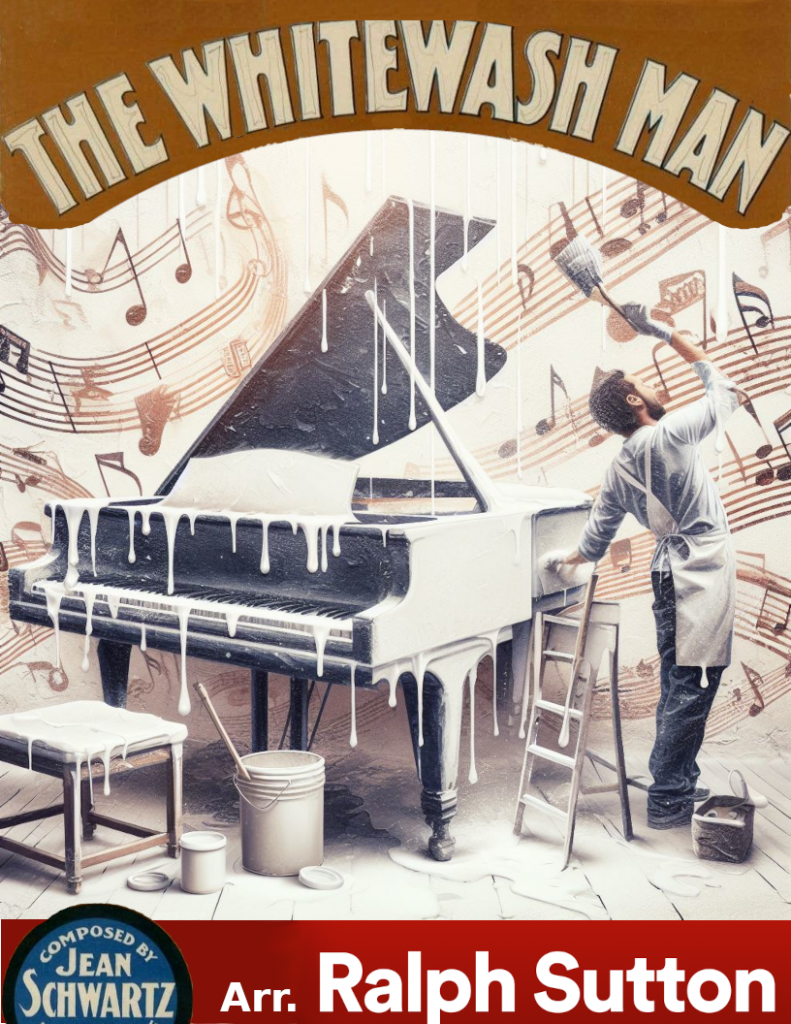
Now, the sheet music transcription:
Mr. Sutton’s tempo is an extremely fast 120 to the quarter note (duration 2:50). During the course of detailed analysis at very slow speeds, I never ran across anything that could be definitively be called a “mistake”. If there were any, they were perfectly integrated into the performance and are part of the transcription.
It was time for the 2019 West Coast Ragtime Festival. I felt motivated to compose another ragtime song. This one took a couple of weeks off and on, and plus a lot of minor edits ever since.
Here is a cover photo generated with the help of AI. [A gazorch is a large slingshot made of a bicycle innertube, often used to fire water balloons out of dormitory windows. You can use your imagination what this has to do with squirrels in the score!]
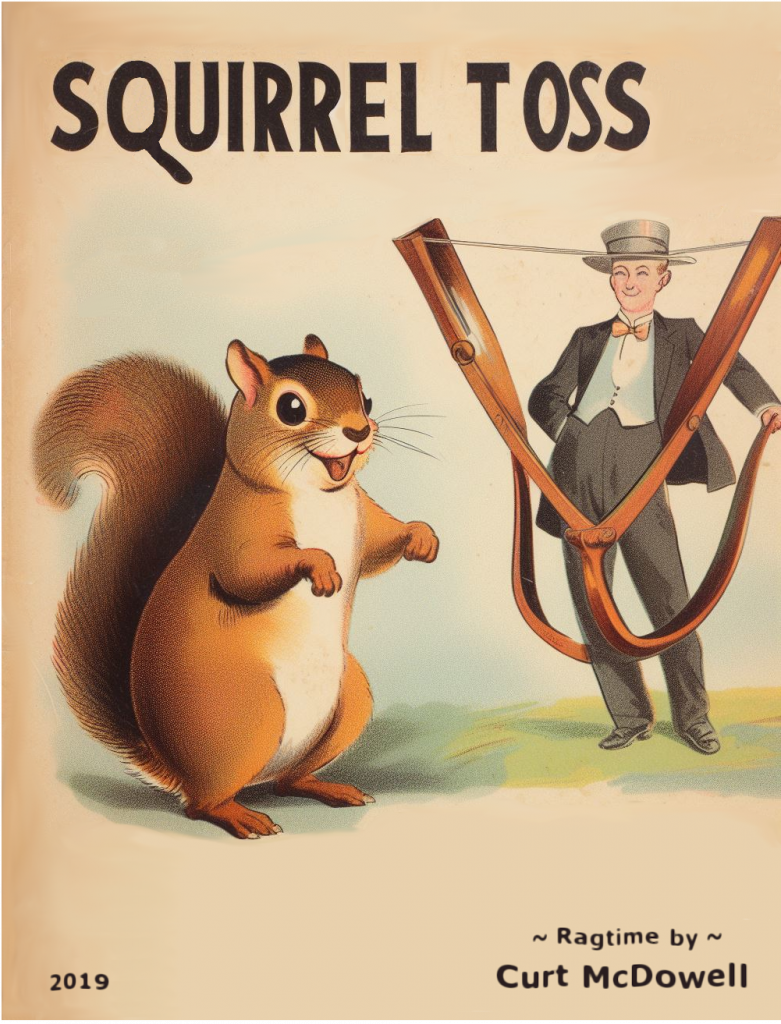
Here is the sheet music, which includes the cover photo.
The recommended tempo is 84 to the quarter note (duration 2:25).
For the first time, I attended the 3-day West Coast Ragtime Festival (2018) in Rancho Cordova, near Sacramento, California. It was about time, as I’ve been playing ragtime since high school and thinking about the festival for several years.
I spent about 3 solid days writing Sinky O, an original ragtime piece. I hoped to perform it during one of the few “open piano” sessions at the festival, which I did, but only a couple people were present and I did a lot of messing up.
There are some rough edges in the piece. The ending is sudden and the minor section is a little limited and repetitive. I may work on it some more.
The name is a play on the term “cinquillo,” which is one of three Spanish rhythms along with the tresillo and habanera. Cinquillo denotes a particular rhythm consisting of: 8th, 16th, 8th, 16th, 8th. Jelly Roll Morton’s works were influenced by Spanish music; he added what he referred to as the “Spanish Tinge”. Some ragtimes (e.g. Solace) were written using habanera.
Here is a cover sheet I designed using the help of generative AI and GIMP.
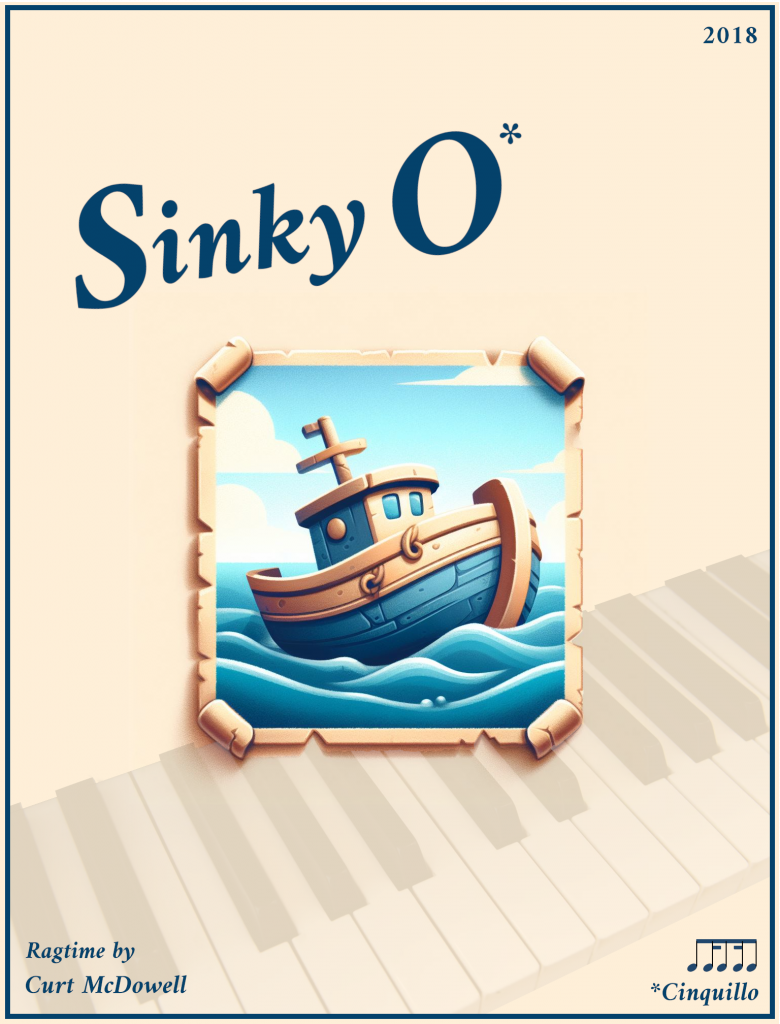
Here is a PDF of the score:
The recommended tempo is 200 to the 8th note (duration 3:00).
If you have not yet seen the original post about my Merry Go transcription for player piano, please read about it here.
The transcription was initially organized in four voices in the Lilypond source file. This made it relatively easy to direct Lilypond to write out a couple extra scores for a single-piano duet version. The two treble voices can be played by Primo, and the two bass voices by Secondo. This shows the power of Lilypond for maintaining multiple renditions from a single source file.
The duet was still not immediately playable. A few chords had too many notes and needed minor tweaks. The last 3 measures needed an alternate playable version; I think I struck a reasonable compromise by having the players alternate the fast final runs, and by reducing the 3-octave run to 2-octave. And in this version, the final chord does not contain all eight C keys on the piano!
As of this writing, the duet has not been performed by two people. I did record myself playing Secondo and then played Primo over it, but there may remain some awkward overlaps with two players on one piano.
If you’d like to print the 6-page duet in book form, I would recommend printing page 4 as simplex, pages 1 and 5 as duplex, pages 2 and 6 as duplex, and page 3 as simplex. Then you’ll be able to have Secondo on the left facing Primo on the right, for 3 pairs of pages. The page numbering is designed with this scheme in mind.
In 2013, I learned to play the Sousa/Horowitz piano transcription as best as I could. I found three sheet music transcriptions (Pellisorius Editions by Jon Skinner; Christian Jensen, 1999; Florian Wolf, 2010). Each edition differed from each other, and also differed from the available audio recordings in minor but unsatisfying ways.
I took it upon myself to create a new, highly accurate transcription of one particular performance by Horowitz: the seminal April 23, 1951 radio broadcast from Carnegie Hall. I attempted to capture as much detail as possible all aspects including notes, dynamics, pedaling, and tempi. I even tried to capture his apparent mistakes, which I have largely indicated in the music. (Of course, this being his own version, “mistakes” is a very subjective term.)
Once again, I relied on Transcribe! software for listening and GNU LilyPond for typesetting. The process took many days.
The PDF file of the sheet music:
The MIDI file generated by LilyPond. I didn’t put much effort into this so the dynamics leave a lot to be desired. Generating a MIDI file was not an objective.
My amateur performance on YouTube:
The original recording I started with was from the video below. A fourth sheet music transcription that is displayed matched to the music doesn’t correspond well.
A couple other notable professional and amateur performances:
When I was 16 and taking piano lessons, my teacher Dr. Barbara Thompson held periodic workshops where 6 or 8 students would get together, explore topics and share compositions. I had handwritten several compositions in a notebook, submitted them for grading, and performed all but the last in the workshops.
Here they are, as usual typeset using GNU LilyPond. First, a PDF of the lot:
(1) Spring Birds, my first composition, actually named in 2011 because I hadn’t named it before and that’s what it sounds like to me. I have changed it to use a simple, pleasing ottavation notation, and have left out voice rests that unnecessarily complicate the simple score. It should be quite trivial to learn for someone who’s heard it. Otherwise, it might take some consideration.

(2) Invention, a short, fast, staccato piece in C minor.
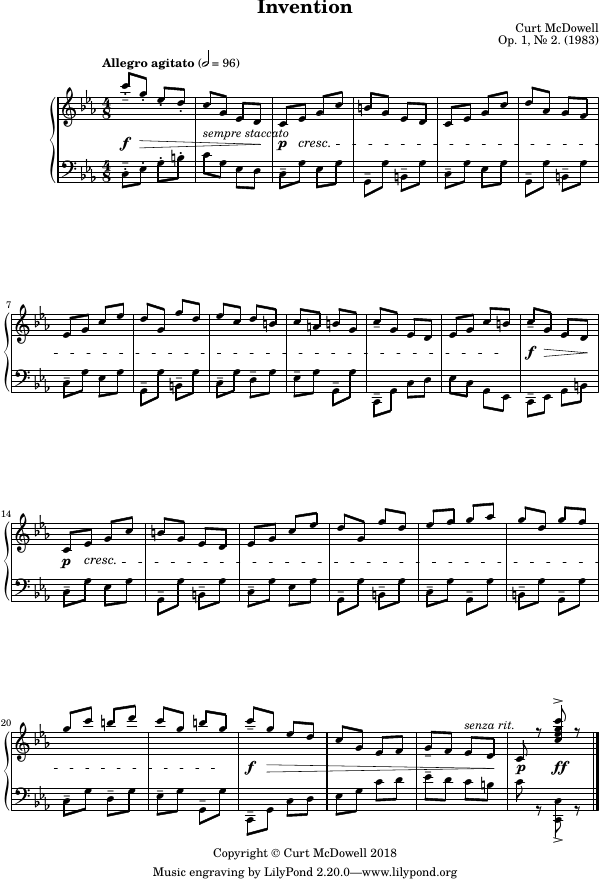
(3) Vivace, a terribly short couple lines that is the least of them.
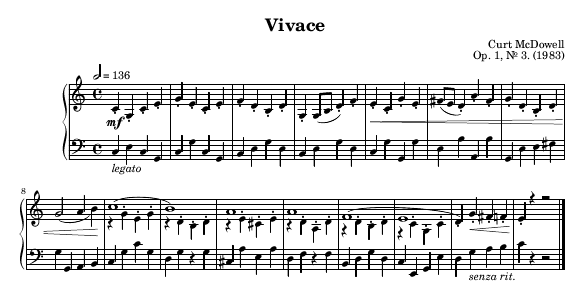
(4) May Daze, with the name gratuitously taken from an event at the Lehigh Valley Hospital Center back in the day. The goal assigned for this piece was to demonstrate key changes as well as a contrapuntal theme that repeated in different voices.
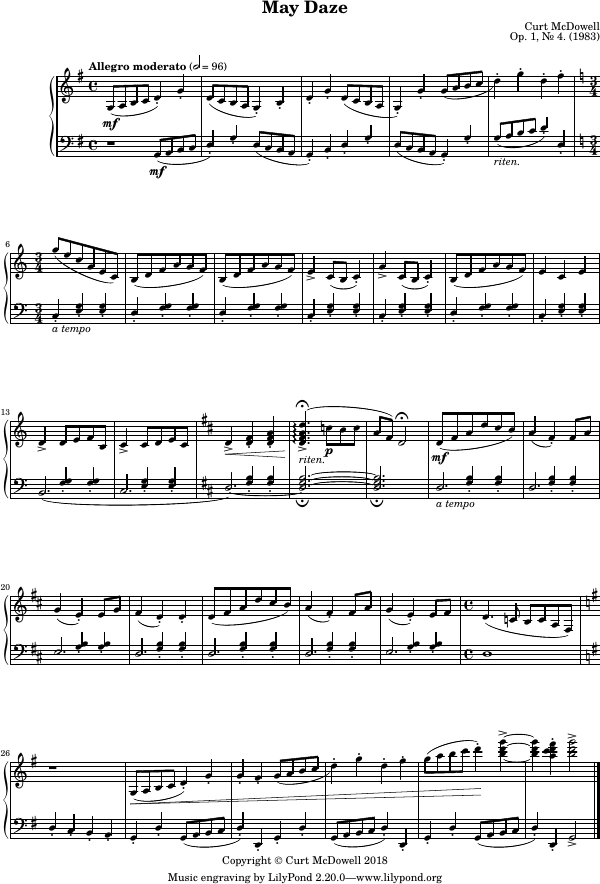
– Warning: some of the tied chords don’t play as tied in the MIDI.
(5) Goldfish Rock, the most fun I think. The syncopated rhythm is hard to grasp at first. At least, so said Mrs. Thompson but she gave it an “A”.
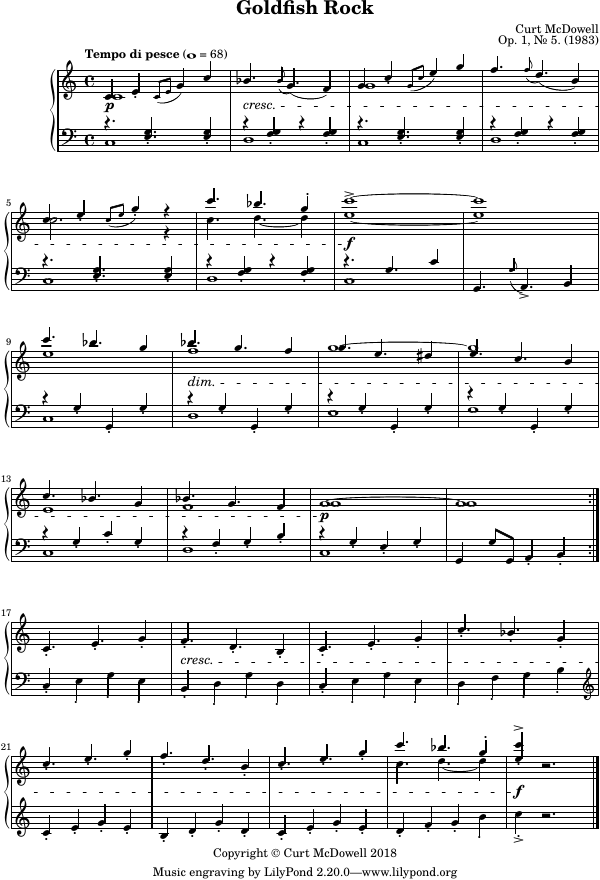
(6) Commodore. This sixth piece was inspired by a two-voice tune that I heard playing on a demo of an 8-bit computer in a Computerland store at the Lehigh Valley mall. It may have been a Commodore VIC-20 or possibly a Sinclair ZX81. Please let me know if you can identify it, which might only be possible if I haven’t scrambled too bad.
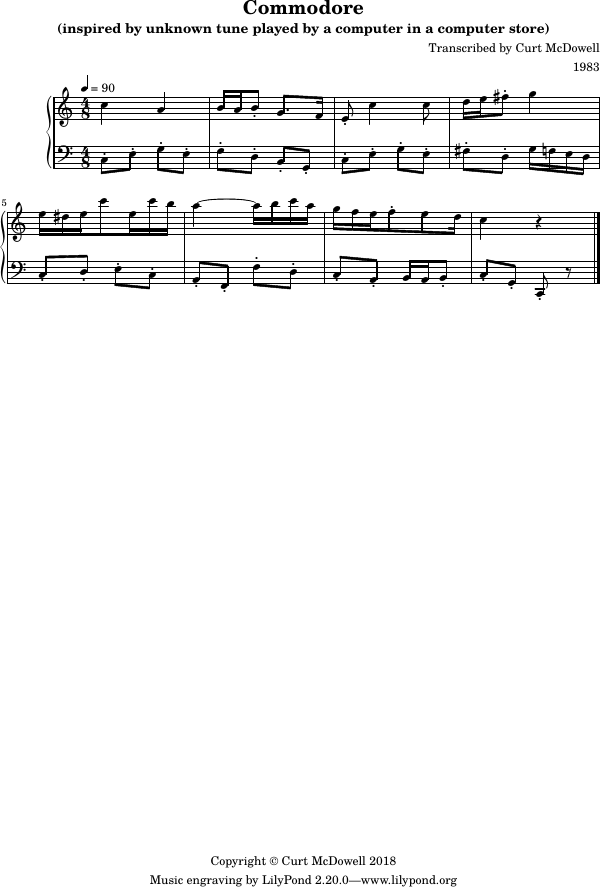
Thank you for trying these admittedly primitive pieces and let me know if you like them!
A few years ago I received the gift of a Rhythm Clocks musical wall clock. Every hour on the hour, it plays one of several short song excerpts. Somehow I identified one of the songs (possibly using SoundHound?) to be a popular waltz from an opera of Delibes.
Title: Coppélia – Waltz from Act I – Valse Lente
Composer: Clémont Philibert Léo Delibes (1836-1891)
I downloaded sheet music for it, edited by Ricardo Boppré. It turns out it was a slightly simplified version that had also been transposed from E flat major to C major. With a GoPro camera I recorded myself playing it for YouTube, here. This has reached 20K+ views, not so deservedly, but this shows the song itself is quite popular.
More recently, I found the “original” E flat version upon which Boppré’s version clearly had been based. I decided it isn’t much more difficult, so I didn’t feel the existence of the C major version was fully justified, and wished I’d recorded the original.
Editor: Henri Heugel
Publisher: Heugel et Compangnie, Au Ménestral, Paris
Date: 1870
I typeset this version into the GNU LilyPond music formatting software. As with Le Chemin de Fer, I tried to make the output look just like the 1870 version, although I didn’t take it quite as far. Here is the LilyPond source file:
The MIDI file generated by LilyPond:
You can play the MIDI file in your browser using the tools from www.midijs.net, but I recommend downloading the MIDI file and playing it natively.
And the PDF file of the sheet music:
With LilyPond, it is near trivial to transpose a piece. In the source code, I have two lines setting the variable “transposeKey”. Simply uncommenting one line or the other selects which key. For grins, here is the C major version of the sheet music:
My first major project using the GNU Lilypond music typesetting software was to re-typeset the piano piece Le Chemin de Fer (The Rail) by Charles-Valentin Alkan. I had seen performances of this fun and ridiculously fast piece on YouTube and tried learning it myself.
Part of the motivation was to create a MIDI file to play it at Alkan’s insane indicated tempo of 112 to the half note, which equates to the right hand playing continuous scales and arpeggios at a rate of nearly 15 notes per second.
I had retrieved a PDF file of the M. R. Braun edition from here. It’s a fancy, historic typeset of this piece. I decided to see how close to identical I could get with Lilypond. It’s not perfect but I can’t imagine getting any closer with other typesetting software. Some of the challenges included:
The LilyPond file is organized into 20 sections, 10 for the left hand and 10 for the right.
The MIDI file is automatically generated when LilyPond is run.
You can play the MIDI file in your browser using the tools from www.midijs.net. The speed is indeed ridiculous.
The final PDF file!
Watch an unbelievable performance of the piece. There are a surprising number of good performances on YouTube, plus many MIDI renditions.